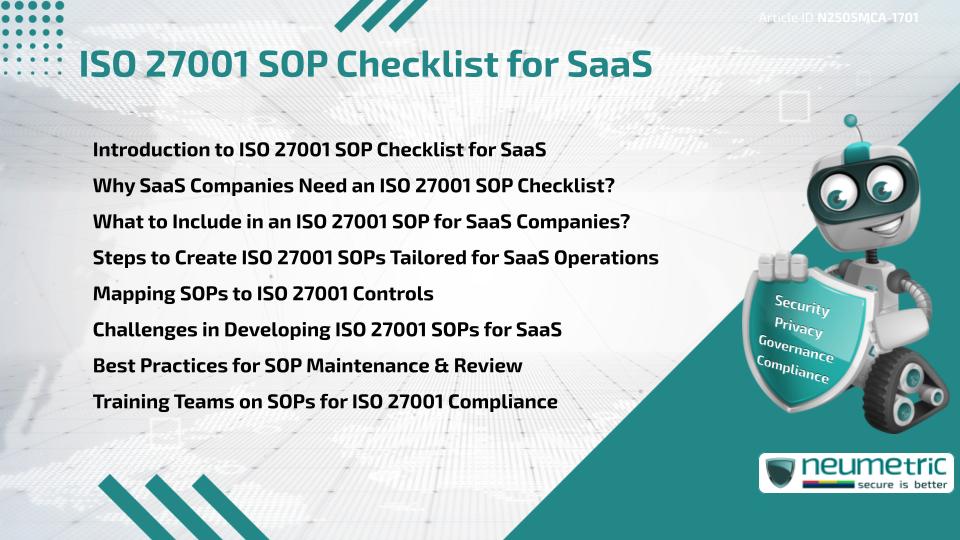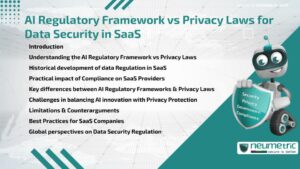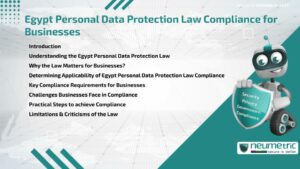Table of Contents
ToggleIntroduction to ISO 27001 SOP Checklist for SaaS
In the world of Software-as-a-Service [SaaS], Security & trust are key. To meet global expectations, SaaS businesses turn to the ISO 27001 standard. But complying with ISO 27001 is not just about Policies & Audits—it is also about implementing clear Standard Operating Procedures [SOPs].
This article explores the purpose & components of an ISO 27001 SOP checklist for SaaS, helping you develop practical, aligned & auditable workflows that meet the expectations of this global security standard.
Why SaaS Companies Need an ISO 27001 SOP Checklist?
For SaaS Providers, ISO 27001 ensures that Information Security Risks are systematically identified & mitigated. A documented SOP checklist ensures repeatable, traceable & compliant operations across the organisation. Without SOPs, even strong Policies may fail in practice.
To address that disconnect, using an ISO 27001 SOP checklist for SaaS helps by:
- Translating Policy into operational tasks
- Ensuring accountability in recurring processes
- Supporting Audit readiness & Evidence Collection
- Making onboarding & cross-team coordination easier
The checklist also aligns with the broader Information Security Management System [ISMS] structure that ISO 27001 requires.
What to Include in an ISO 27001 SOP for SaaS Companies?
An effective ISO 27001 SOP checklist for SaaS should include Procedures across various operational areas. These commonly include:
- Access Control: How User accounts are created, updated or removed
- Asset management: Define clear steps for identifying, documenting & protecting both physical & digital assets used across the organisation.
- Change management: How software updates are documented & deployed
- Incident Handling: Clearly defined procedures to follow before, during & after any security event or breach
- Data backup & recovery: Frequency, storage locations & restoration steps
- Vendor management: Due diligence & security checks for third parties
Each SOP must include a clear purpose, scope, roles, inputs, steps & references to related controls.
Steps to Create ISO 27001 SOPs Tailored for SaaS Operations
SaaS environments are dynamic. To make sure your SOPs align with day-to-day business functions, it is best to take a step-by-step approach like :
- Start by identifying possible risks in your environment—this helps uncover process gaps & security weaknesses.
- Engage each team (e.g. DevOps, HR, Customer Success) to describe current processes
- Document procedures using a consistent template across departments
- Cross-reference procedures with ISO 27001 controls & asset registers
- Before locking in your SOPs, run simulations & gather feedback to ensure they work effectively in real scenarios.
Mapping SOPs to ISO 27001 Controls
Each SOP should link back to a specific ISO 27001 Annex A control. For example:
- A.9.2.2: SOP for granting & removing User access
- A.12.5.1: SOP for managing software installation & updates
- A.16.1.5: SOP for focusing on Procedures for responding to & analysing Security Incidents to strengthen future Readiness.
Your everyday activities & the Audit-ready structure of ISO 27001 are connected by a successful SaaS ISO 27001 SOP checklist.
Challenges in Developing ISO 27001 SOPs for SaaS
Even mature SaaS companies can struggle with SOP development. Common hurdles include:
- Teams operating in silos without shared terminology
- Difficulty translating technical processes into formal Procedures
- Lack of time to review or update SOPs regularly
- Overly complex or under-documented workflows
To avoid these issues, start small, use a common format & focus on practicality over perfection.
Best Practices for SOP Maintenance & Review
Creating SOPs is only the first step. Maintaining them is where most companies fall short.
To stay compliant:
- Ensure each SOP is reviewed & updated at least once every twelve (12) months to stay aligned with operational & compliance requirements.
- Involve process owners in updates to ensure relevance
- Log version histories & approvals for each SOP
- Make SOPs easily accessible through secure internal tools
Training Teams on SOPs for ISO 27001 Compliance
A checklist is only useful if the team follows it. That is where training matters.
- Conduct quarterly awareness sessions on key SOPs
- Use role-based training to focus on relevant Procedures
- Evaluate understanding through simple Audits or quizzes
- Encourage feedback to improve clarity & usability
Without awareness, SOPs become shelfware. Make sure every Employee knows what to do & why.
Takeaways
- The ISO 27001 SOP checklist for SaaS turns policy into action
- Clear documentation supports Audit readiness & team accountability
- SOPs must reflect real SaaS workflows & stay updated
- Tools & training are critical for sustained Compliance
- Mapping SOPs to ISO controls makes certification easier & more structured
FAQ
What is an ISO 27001 SOP checklist for SaaS?
It is a structured list of documented procedures designed to help SaaS companies meet ISO 27001 requirements through operational clarity & repeatability.
How does this checklist help with Compliance?
It translates ISO 27001 Policies into everyday tasks that can be followed, tracked & audited for Compliance during assessments.
Who should be involved in creating SOPs?
Teams like DevOps, HR, IT Security & Customer Success should collaborate, since each handles tasks that impact Information Security.
Can you use templates to create SOPs?
Of course. Templates help streamline processes while ensuring tasks are performed in a uniform & efficient manner. Be sure to customise them based on the unique structure & operational needs of your organisation.
Is having SOPs required for ISO 27001 certification?
If an organisation lacks written procedures, it becomes challenging to prove that its security measures are implemented uniformly & managed in a controlled manner.
Is there a difference between SOPs & Policies?
Yes. Policies set the rules, while SOPs define how those rules are followed in daily operations.
Do SOPs have to follow a specific format?
ISO does not mandate a particular layout for SOPs, but using a consistent format makes them easier to read, apply & maintain across your organisation.
Need help?
Neumetric provides organisations the necessary help to achieve their Cybersecurity, Compliance, Governance, Privacy, Certifications & Pentesting goals.
Organisations & Businesses, specifically those which provide SaaS & AI Solutions, usually need a Cybersecurity Partner for meeting & maintaining the ongoing Security & Privacy needs & requirements of their Clients & Customers.
SOC 2, ISO 27001, ISO 42001, NIST, HIPAA, HECVAT, EU GDPR are some of the Frameworks that are served by Fusion – a centralised, automated, AI-enabled SaaS Solution created & managed by Neumetric.
Reach out to us!





